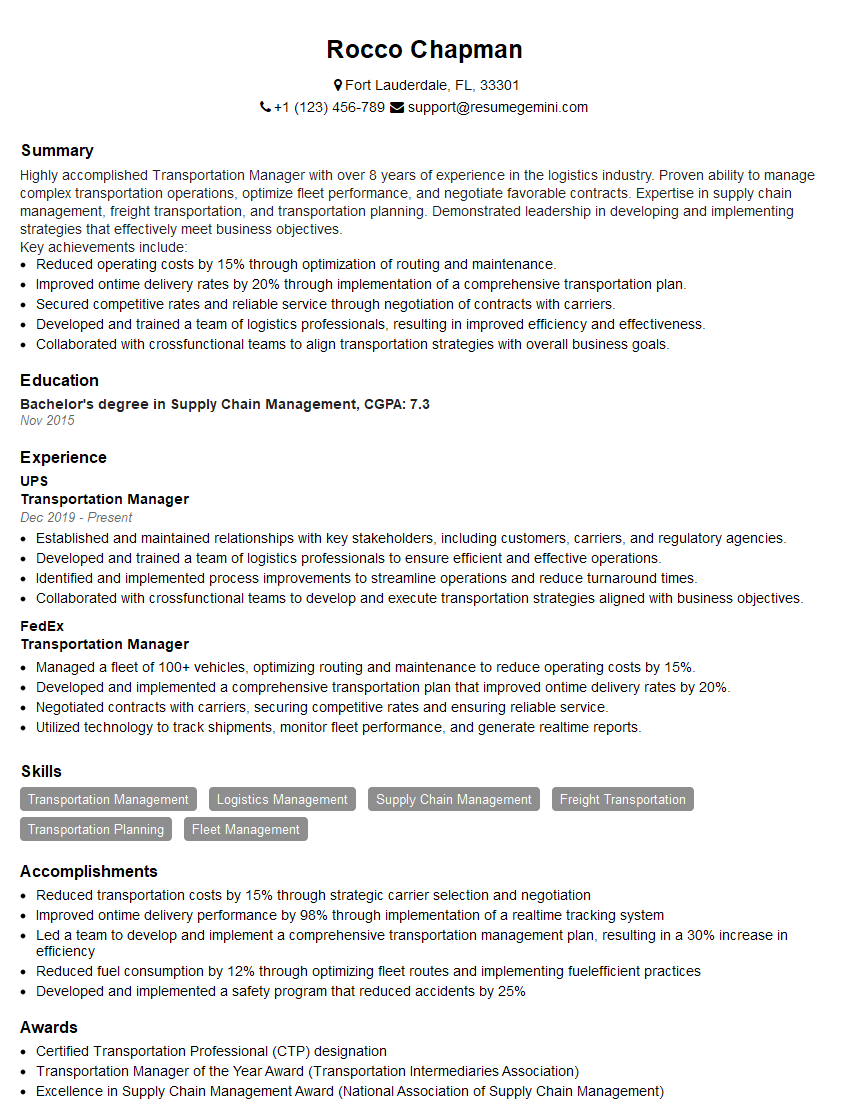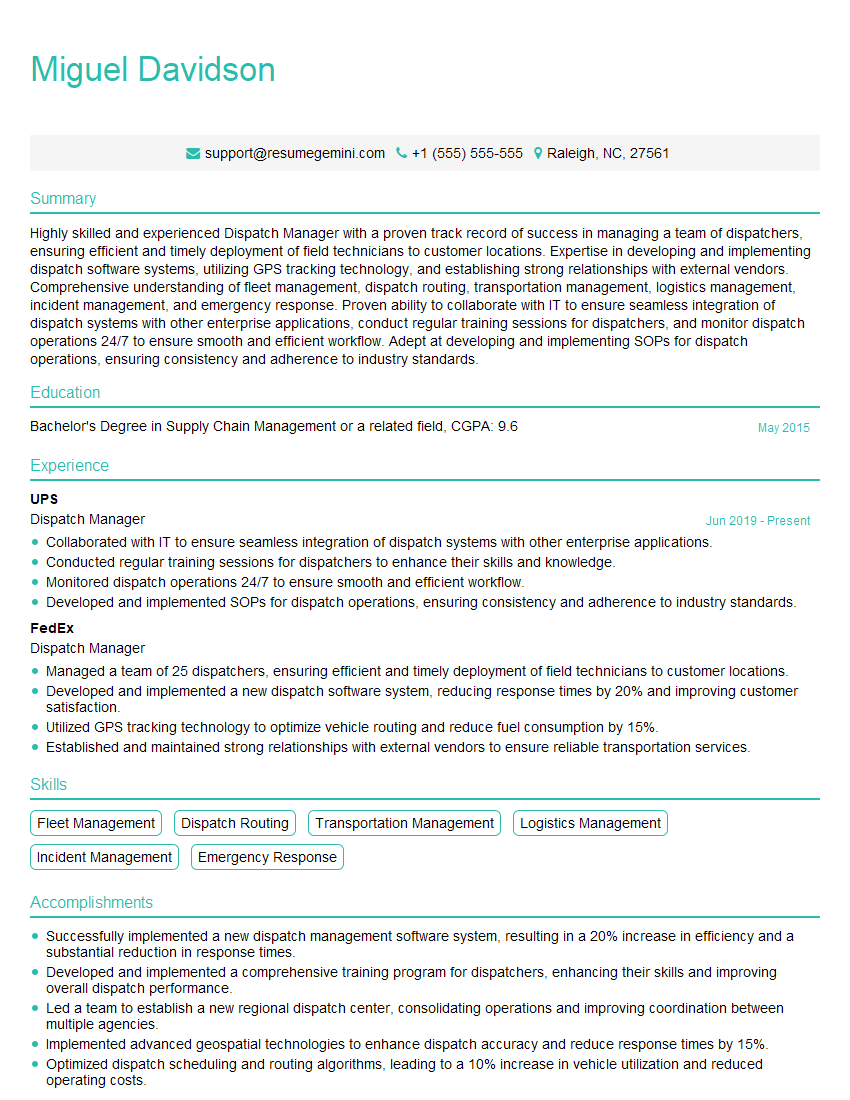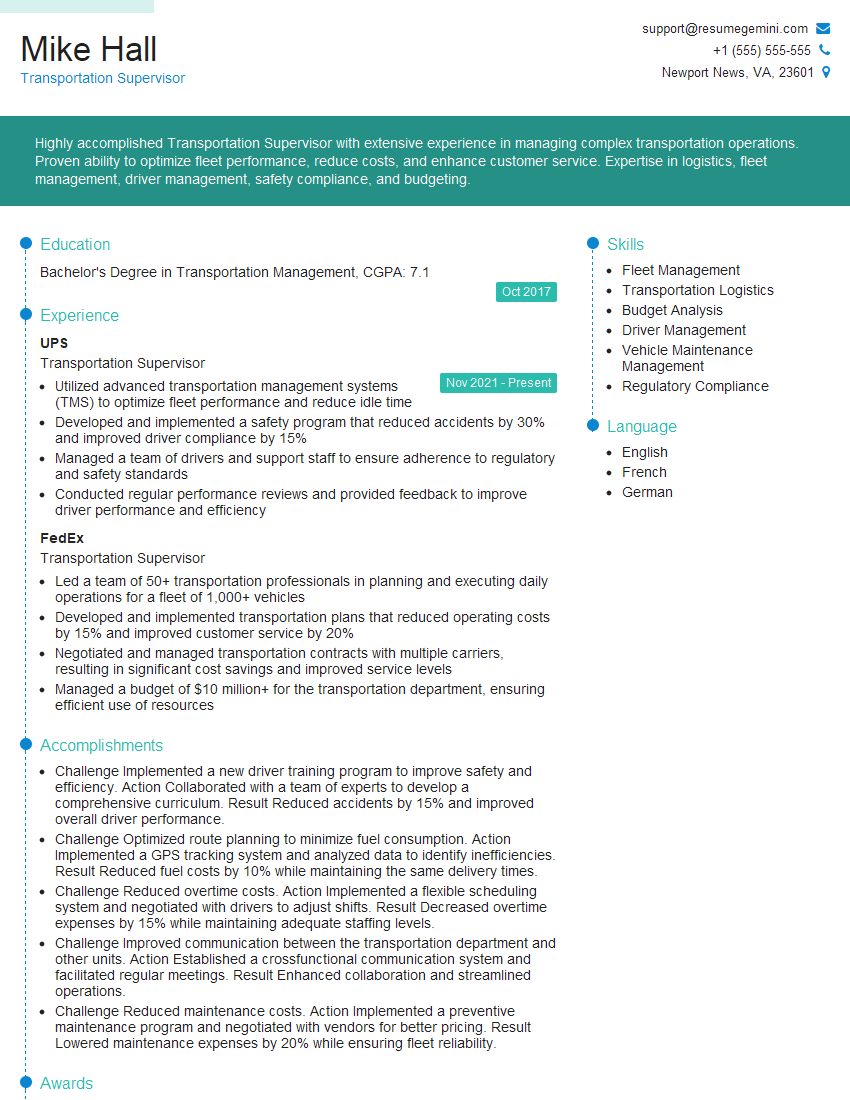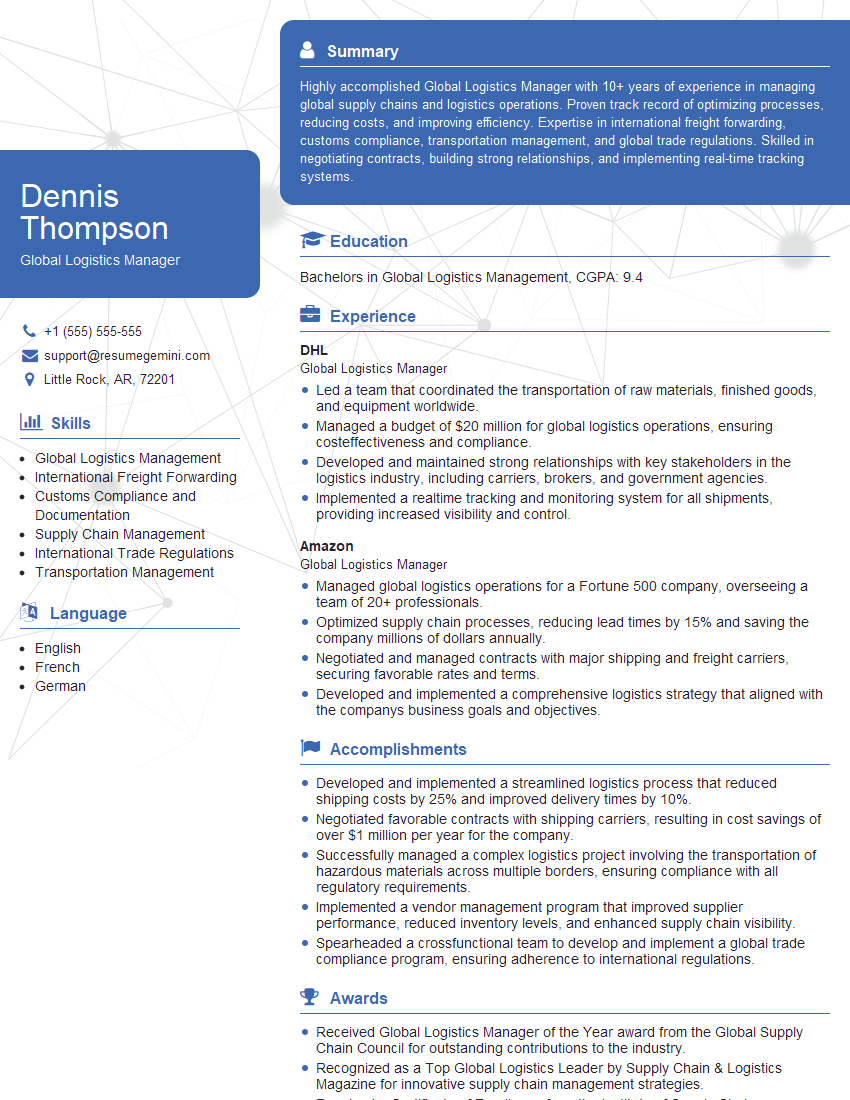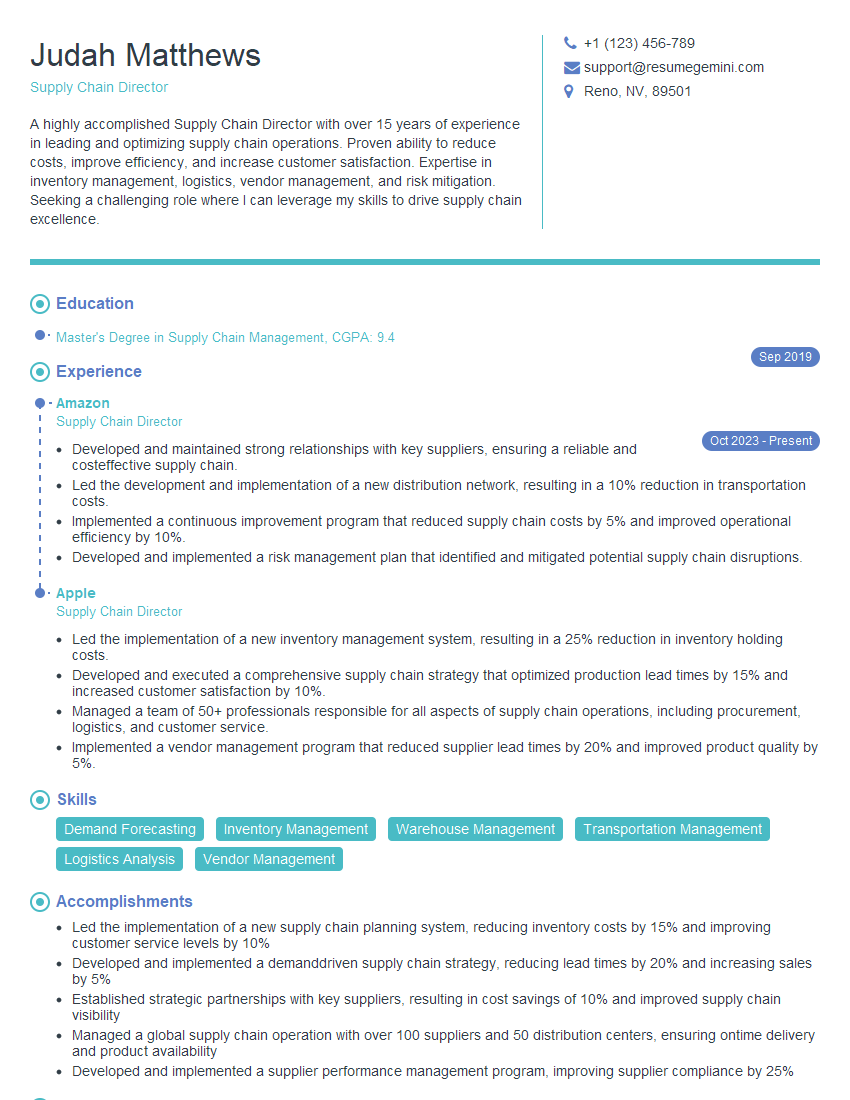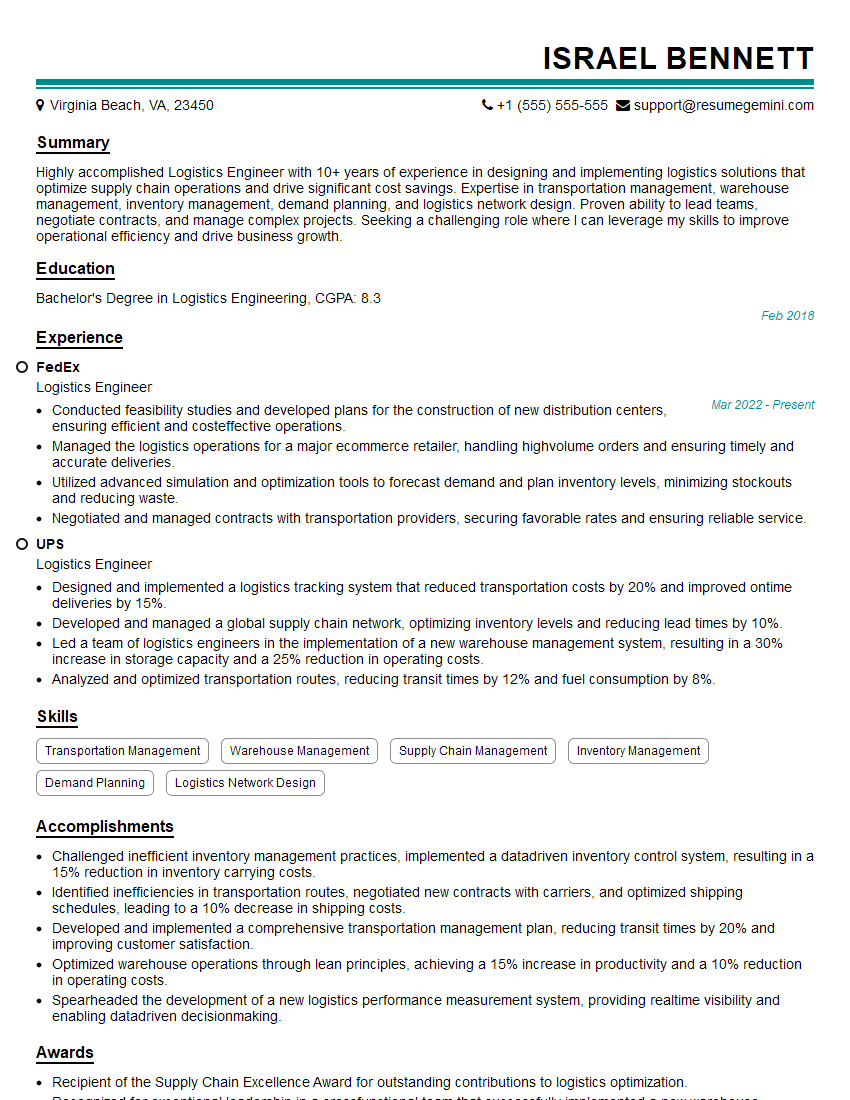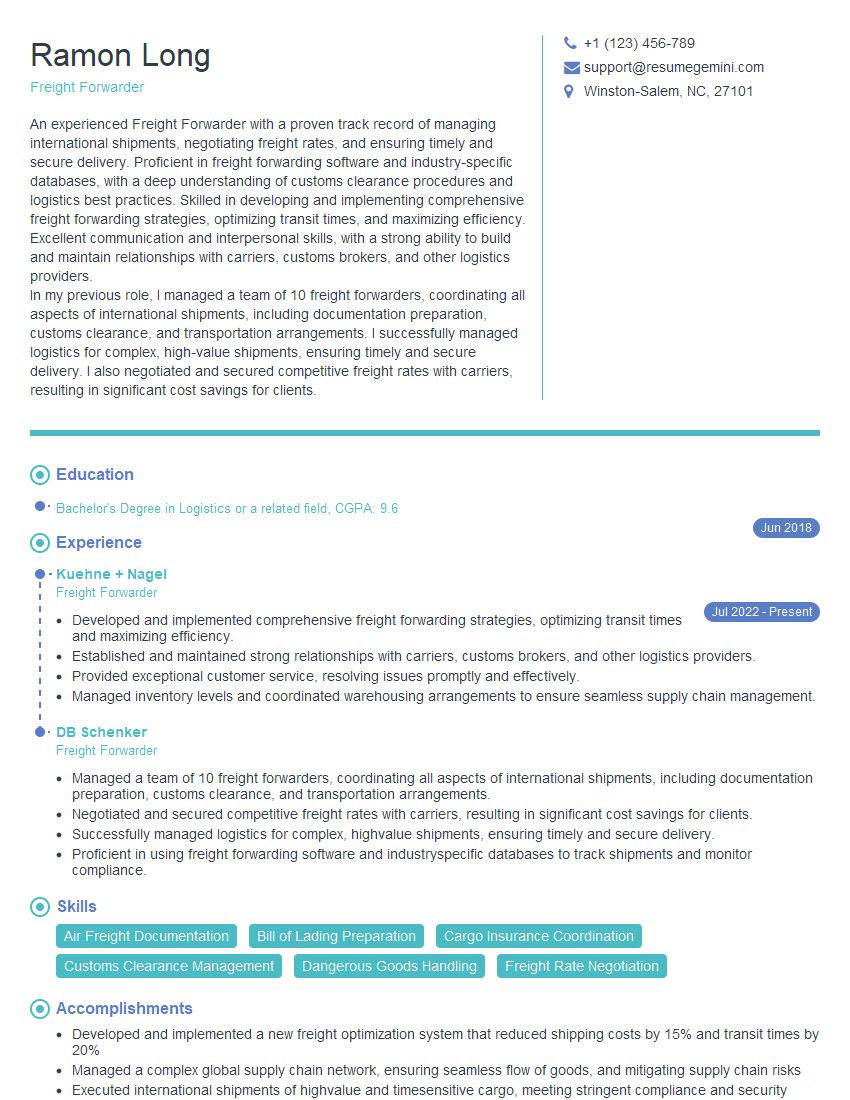Unlock your full potential by mastering the most common Log Logistics interview questions. This blog offers a deep dive into the critical topics, ensuring you’re not only prepared to answer but to excel. With these insights, you’ll approach your interview with clarity and confidence.
Questions Asked in Log Logistics Interview
Q 1. Explain the difference between LTL and FTL shipping.
LTL (Less than Truckload) and FTL (Full Truckload) shipping are two distinct methods for transporting goods by truck, differing primarily in the amount of cargo shipped. FTL involves utilizing an entire truck for a single shipment, ideal for large volumes. Think of it like renting an entire apartment – you have all the space. LTL, conversely, consolidates smaller shipments from multiple shippers onto a single truck, sharing the space and cost. It’s like sharing a house – you only pay for your portion.
LTL advantages: Cost-effective for smaller shipments, broader network access.
LTL disadvantages: Longer transit times due to multiple stops, higher risk of damage or loss.
FTL advantages: Faster transit times, greater security and control over the shipment.
FTL disadvantages: More expensive for smaller shipments, less flexibility in scheduling.
Example: A furniture manufacturer shipping 100 chairs might use FTL. A small online retailer shipping 10 individual packages to different customers would likely use LTL.
Q 2. Describe your experience with Warehouse Management Systems (WMS).
My experience with Warehouse Management Systems (WMS) spans over eight years, encompassing implementation, optimization, and daily operation. I’ve worked with various WMS platforms, including NetSuite WMS, Manhattan Associates, and Blue Yonder. My responsibilities have involved everything from designing efficient warehouse layouts and configuring system parameters to integrating WMS with other enterprise resource planning (ERP) systems and managing inventory control processes.
For example, at my previous role, we implemented a new WMS that reduced picking errors by 15% and increased order fulfillment speed by 20%. This involved detailed process mapping, extensive training for warehouse staff, and ongoing performance monitoring. We used the system’s reporting capabilities to identify bottlenecks and optimize workflows, leading to significant cost savings and increased efficiency.
I’m proficient in utilizing WMS functionalities such as inventory tracking, order management, putaway strategies (e.g., zone picking, cluster picking), and warehouse labor management tools. I’m also experienced in integrating WMS data with transportation management systems (TMS) to ensure seamless order fulfillment from warehouse to customer.
Q 3. How do you optimize transportation routes for cost efficiency?
Optimizing transportation routes for cost efficiency requires a multi-faceted approach. My strategy typically involves employing route optimization software combined with practical knowledge and experience. Software helps to factor in various parameters like distance, traffic patterns, delivery windows, and fuel costs, generating the most efficient routes. However, software alone isn’t sufficient.
I always consider factors like driver familiarity with specific routes, potential road closures or construction, and the need for specialized equipment. For instance, a route with fewer turns and less stop-and-go traffic can significantly reduce fuel consumption. Consolidating shipments whenever possible also plays a crucial role in optimizing costs. By combining multiple smaller shipments into one larger shipment, we can utilize full truckloads and reduce the per-unit cost of transportation.
Furthermore, regular monitoring and analysis of route performance are key. We track key metrics like fuel consumption, delivery times, and mileage to identify areas for improvement and continuously refine our routing strategies.
Q 4. What are the key performance indicators (KPIs) you track in logistics?
In logistics, several Key Performance Indicators (KPIs) are crucial for evaluating performance and identifying areas for improvement. These are often categorized into areas like cost, efficiency, and customer service.
- On-Time Delivery Rate: Percentage of shipments delivered on or before the scheduled delivery date.
- Order Fulfillment Cycle Time: Time taken from order placement to delivery.
- Inventory Turnover Rate: How quickly inventory is sold and replenished.
- Transportation Costs per Unit: Cost of transportation per unit of goods shipped.
- Warehouse Operating Costs: Total cost of running the warehouse, including labor, rent, and utilities.
- Customer Satisfaction Rate: Measured through surveys and feedback mechanisms.
- Perfect Order Rate: Percentage of orders delivered on time, in full, and without errors.
By tracking these KPIs, we can identify bottlenecks in the supply chain and make data-driven decisions to improve efficiency and reduce costs. Regular reporting and analysis of these metrics are crucial for proactive management.
Q 5. Explain your understanding of Incoterms.
Incoterms, or International Commercial Terms, are standardized trade terms published by the International Chamber of Commerce (ICC). They define the responsibilities of buyers and sellers in international trade transactions, specifying who is responsible for costs, risks, and documentation at different stages of the shipment. Understanding Incoterms is vital for avoiding disputes and ensuring smooth international trade.
For instance, EXW (Ex Works) places the maximum responsibility on the buyer, while DDP (Delivered Duty Paid) places it on the seller. Selecting the appropriate Incoterm depends heavily on the specific circumstances of the transaction, including the nature of the goods, the transportation mode, and the relationship between buyer and seller. Misinterpreting or neglecting Incoterms can lead to substantial financial and logistical complications.
My experience includes negotiating Incoterms in international contracts, ensuring the terms align with the overall transaction and risk profile. I’m familiar with the nuances of various Incoterms and can advise on the most suitable option for any given scenario.
Q 6. How do you handle unexpected delays in the supply chain?
Handling unexpected delays requires a proactive and structured approach. My first step is to identify the root cause of the delay. This involves communicating with all relevant parties – carriers, suppliers, and customers – to gather information and assess the situation. Once the cause is identified (e.g., weather disruptions, port congestion, or equipment failure), we develop a contingency plan.
This plan might involve rerouting shipments, finding alternative transportation modes, expediting deliveries, or negotiating with customers for extended delivery windows. Transparent communication with customers is paramount, keeping them informed of the situation and providing realistic estimates for revised delivery times. We also analyze the root cause of the delay to prevent similar situations in the future, perhaps by diversifying suppliers or improving risk management processes. Documentation is crucial, recording all communication, decisions made, and any financial impacts associated with the delay.
Q 7. Describe your experience with inventory management techniques.
My experience encompasses various inventory management techniques, including Just-in-Time (JIT), Economic Order Quantity (EOQ), and ABC analysis. JIT aims to minimize inventory holding costs by receiving materials only when needed for production or fulfillment. EOQ calculates the optimal order quantity to minimize total inventory costs. ABC analysis categorizes inventory items based on their value and consumption rate, focusing resources on the most critical items (A-items).
In practice, I’ve used these techniques to optimize inventory levels, reduce storage costs, and minimize stockouts. For example, I implemented an ABC analysis for a client, which allowed us to focus on the top 20% (A-items) that accounted for 80% of the inventory value, leading to more effective inventory control and better allocation of resources. I also have experience using inventory management software, enabling data-driven decision-making regarding stock levels and ordering practices. Successful inventory management relies on accurate forecasting, effective demand planning, and robust inventory tracking systems.
Q 8. How do you manage relationships with third-party logistics providers (3PLs)?
Managing relationships with 3PLs is crucial for efficient logistics. It’s not just about finding the cheapest provider; it’s about building a partnership based on trust, transparency, and shared goals. This involves several key steps:
- Careful Selection: Thorough due diligence is paramount. I assess a 3PL’s track record, technological capabilities, insurance coverage, and their understanding of our specific needs. References and site visits are essential.
- Clear Communication: Establishing clear communication channels—regular meetings, shared dashboards, and defined escalation procedures—is key to preventing misunderstandings and resolving issues promptly. We use collaborative platforms to track shipments and share real-time data.
- Performance Monitoring: We establish Key Performance Indicators (KPIs) like on-time delivery rates, damage rates, and cost efficiency. These KPIs are regularly monitored and reviewed with the 3PL to identify areas for improvement and address any performance gaps. We utilize data analytics to pinpoint bottlenecks and optimize processes.
- Contract Management: A well-defined contract outlining service level agreements (SLAs), payment terms, and liability is crucial. This document should clearly specify responsibilities and expectations for both parties.
- Relationship Building: Open communication, mutual respect, and proactive problem-solving build strong, long-term partnerships. Regular communication goes beyond just addressing issues; it also fosters trust and allows for collaborative improvements.
For example, in a previous role, I successfully negotiated a contract with a 3PL that resulted in a 15% reduction in our transportation costs while maintaining excellent service levels. This was achieved by leveraging their expertise in route optimization and negotiating favorable rates with their carrier network.
Q 9. What is your experience with forecasting demand?
Accurate demand forecasting is the backbone of efficient logistics. My approach involves a combination of quantitative and qualitative methods.
- Historical Data Analysis: I utilize time series analysis techniques to identify trends and seasonality in past demand patterns. This involves using statistical software to model demand and predict future needs.
- Market Research: Understanding market trends, economic indicators, and competitor activity is critical. This can involve reviewing market reports, conducting customer surveys, and analyzing industry news.
- Sales & Marketing Input: Close collaboration with sales and marketing teams is essential to incorporate their insights on planned promotions, new product launches, and expected sales volumes. This helps in predicting surges or dips in demand.
- External Factors: Considering external factors such as weather patterns, geopolitical events, and economic fluctuations that may impact demand is also crucial. For example, a severe weather event could significantly disrupt supply chains.
- Forecasting Software: I have experience using sophisticated forecasting software packages that employ advanced algorithms to generate more accurate predictions. These tools allow for scenario planning and sensitivity analysis.
In one project, I implemented a new forecasting model that reduced forecast errors by 20%, leading to significant improvements in inventory management and reduced storage costs. The new model incorporated machine learning algorithms to account for previously uncaptured variables impacting demand.
Q 10. Explain your knowledge of different transportation modes (e.g., air, sea, rail, road).
Choosing the right transportation mode is critical for optimizing cost and delivery time. Each mode has its own strengths and weaknesses:
- Road: Offers flexibility and door-to-door delivery, ideal for smaller shipments and time-sensitive goods. However, it can be slower over long distances and susceptible to traffic congestion.
- Rail: Cost-effective for large volumes over long distances, but less flexible than road transport and requires rail access points. Suitable for bulk goods and less time-sensitive shipments.
- Sea: The most economical option for extremely large volumes and long distances, but significantly slower than other modes. Prone to delays due to weather conditions and port congestion. Ideal for international shipping of bulk commodities.
- Air: Fastest mode, ideal for time-sensitive and high-value goods. However, it is the most expensive option and has limitations on cargo size and weight. Excellent for perishable goods and emergency shipments.
Selecting the optimal mode often involves a trade-off between speed, cost, and reliability. I often use transportation management systems (TMS) to model different scenarios and determine the most cost-effective and efficient combination of modes for a given shipment.
Q 11. How do you ensure compliance with relevant regulations and safety standards?
Compliance is paramount in logistics. It encompasses several key areas:
- Safety Regulations: Adherence to all relevant safety regulations, including those related to hazardous materials transportation (e.g., HAZMAT), vehicle maintenance, and driver hours of service is critical. Regular audits and training are essential.
- Customs Regulations: For international shipments, compliance with customs regulations, including proper documentation and tariff classifications, is crucial to avoid delays and penalties. We work closely with customs brokers to ensure smooth clearance.
- Data Privacy: Protecting sensitive customer and shipment data is crucial, requiring compliance with regulations like GDPR. We implement robust data security measures and maintain strict data privacy policies.
- Environmental Regulations: We strive for environmentally responsible practices, including minimizing emissions and adhering to regulations concerning waste disposal and fuel efficiency. This can involve using alternative fuels or optimizing routes.
- Insurance and Liability: Appropriate insurance coverage is essential to protect against potential losses or damages during transit. Understanding liability clauses in contracts with carriers and 3PLs is vital.
We conduct regular internal audits and invest in training programs to ensure ongoing compliance. We also actively monitor changes in regulations to adapt our processes accordingly.
Q 12. How do you handle customer complaints or issues related to logistics?
Handling customer complaints effectively is crucial for maintaining customer satisfaction. My approach involves:
- Prompt Acknowledgement: Addressing complaints quickly and acknowledging the customer’s frustration is the first step. A timely response shows that we value their business.
- Thorough Investigation: A thorough investigation of the issue is conducted to identify the root cause. This may involve reviewing tracking data, contacting the carrier, or inspecting damaged goods.
- Transparent Communication: Keeping the customer informed throughout the investigation and resolution process is vital. We provide updates on the progress and avoid making false promises.
- Fair Resolution: Depending on the nature of the complaint, we offer a fair resolution, which may involve a refund, replacement, or compensation for damages. We strive to exceed customer expectations in finding a solution.
- Feedback Mechanism: We encourage feedback to continuously improve our processes and prevent future issues. Customer feedback helps us identify areas needing improvement and refine our procedures.
For example, I once resolved a customer complaint regarding a delayed shipment by proactively communicating with the carrier, identifying the cause of the delay, and arranging for expedited delivery. The customer was impressed by our swift response and proactive solution.
Q 13. Describe a time you had to solve a complex logistics problem.
In a previous role, we faced a major disruption when a key supplier experienced a fire, halting production and threatening a major product launch. This created a critical shortage of essential components. Here’s how we solved the problem:
- Emergency Response Team: We immediately formed a cross-functional team to address the crisis. This involved representatives from procurement, logistics, production, and customer service.
- Alternative Sourcing: We quickly identified and qualified alternative suppliers for the affected component. This involved rigorous quality checks and negotiation of expedited delivery terms.
- Air Freight: Given the time sensitivity, we opted for air freight to expedite delivery from the alternative suppliers. This increased the transportation cost but ensured that the product launch wouldn’t be delayed significantly.
- Communication with Customers: We proactively communicated with our customers about the situation and potential impact on delivery timelines. Transparency and honest communication helped maintain customer trust.
- Post-Incident Review: After the crisis, we conducted a thorough review to identify areas for improvement in our supply chain resilience. This included developing contingency plans and diversifying our supplier base.
Despite the initial setback, we successfully mitigated the disruption and delivered the product on time, minimizing the negative impact on our customers and reputation. This experience reinforced the importance of proactive risk management and crisis preparedness in logistics.
Q 14. What is your experience with implementing lean logistics principles?
Lean logistics focuses on eliminating waste and maximizing efficiency throughout the supply chain. My experience includes:
- Waste Identification: Identifying and analyzing different types of waste, such as excess inventory, unnecessary transportation, and waiting time, is a key first step. Value stream mapping helps to visualize the flow of materials and processes to pinpoint areas of inefficiency.
- Process Optimization: Implementing process improvements to streamline operations and reduce waste. This may involve optimizing warehouse layout, improving inventory management techniques, or using technology to automate processes.
- Inventory Management: Employing techniques such as Just-in-Time (JIT) inventory management to minimize storage costs and reduce waste associated with excess inventory. This necessitates close collaboration with suppliers and accurate demand forecasting.
- Transportation Optimization: Optimizing transportation routes and modes to minimize transportation costs and reduce transit times. This may involve utilizing route optimization software or negotiating favorable rates with carriers.
- Continuous Improvement: Employing methodologies like Kaizen and 5S to foster a culture of continuous improvement and regularly evaluate and improve processes.
In one project, I implemented a lean logistics program that resulted in a 10% reduction in lead times and a 15% reduction in inventory holding costs. This was achieved by optimizing warehouse layout, improving inventory management practices, and implementing a new transportation management system.
Q 15. How do you utilize technology to improve logistics efficiency?
Technology is absolutely crucial for boosting logistics efficiency. Think of it as the engine that drives the entire operation. I leverage technology in several key ways:
- Transportation Management Systems (TMS): These systems optimize routes, track shipments in real-time, and automate dispatching, reducing fuel costs and delivery times. For instance, I’ve used TMS software to identify a more efficient route for a client, saving them 15% on fuel costs in a single quarter.
- Warehouse Management Systems (WMS): WMS streamlines warehouse operations, from receiving and putaway to picking, packing, and shipping. This includes managing inventory levels, optimizing storage space, and directing warehouse staff for maximum productivity. I implemented a WMS for a client that reduced their order fulfillment time by 20%.
- Data Analytics and Business Intelligence (BI): Analyzing data from various sources – TMS, WMS, customer relationship management (CRM) systems, etc. – helps identify bottlenecks, predict demand, and improve forecasting accuracy. We used BI to predict a surge in demand for a particular product and proactively adjusted our inventory and logistics strategy, preventing stockouts.
- Internet of Things (IoT): Using sensors and tracking devices on shipments provides real-time visibility, improving security and enabling proactive issue resolution. For example, if a temperature-sensitive shipment deviates from the ideal temperature range, we get an immediate alert and can take corrective action.
- Route optimization software: Advanced algorithms help optimize delivery routes, considering factors like traffic, distance, and delivery windows. This leads to faster deliveries and reduced operational costs.
The synergistic use of these technologies creates a highly efficient and responsive logistics network.
Career Expert Tips:
- Ace those interviews! Prepare effectively by reviewing the Top 50 Most Common Interview Questions on ResumeGemini.
- Navigate your job search with confidence! Explore a wide range of Career Tips on ResumeGemini. Learn about common challenges and recommendations to overcome them.
- Craft the perfect resume! Master the Art of Resume Writing with ResumeGemini’s guide. Showcase your unique qualifications and achievements effectively.
- Don’t miss out on holiday savings! Build your dream resume with ResumeGemini’s ATS optimized templates.
Q 16. What is your familiarity with different types of warehousing (e.g., cross-docking, bulk storage)?
My experience encompasses a variety of warehousing types, each tailored to different product characteristics and operational needs:
- Cross-docking: This is a fast-paced method where goods are unloaded from incoming shipments and immediately loaded onto outgoing shipments, minimizing storage time. It’s ideal for high-volume, fast-moving goods. I’ve successfully implemented cross-docking strategies for clients in the fast-moving consumer goods (FMCG) sector, significantly reducing their warehousing costs.
- Bulk storage: Suitable for large quantities of homogenous goods, like grains or raw materials. It requires specialized equipment and facilities for efficient handling. I’ve worked with clients in the agricultural sector, optimizing their bulk storage facilities to minimize losses due to spoilage or damage.
- Value-added warehousing: This involves performing additional services on goods while in storage, such as labeling, packaging, or kitting. I have overseen projects incorporating value-added services, leading to improved product presentation and increased customer satisfaction.
- Temperature-controlled warehousing: Essential for storing perishable goods or temperature-sensitive products. I’ve managed the logistics for pharmaceutical companies, ensuring strict adherence to temperature regulations throughout the entire supply chain.
The choice of warehousing type depends heavily on the specific products, client needs, and overall supply chain strategy.
Q 17. How do you manage risk within a logistics operation?
Risk management in logistics is paramount. I employ a multi-layered approach:
- Risk Identification: Thorough assessment of potential risks, including natural disasters, supply chain disruptions, geopolitical instability, theft, and damage. We use various tools and techniques, including SWOT analysis and risk registers.
- Risk Assessment: Evaluating the likelihood and impact of each identified risk. This helps prioritize which risks require immediate attention.
- Risk Mitigation: Developing strategies to reduce or eliminate risks. This could include diversifying suppliers, implementing robust security measures, investing in insurance, and establishing contingency plans.
- Contingency Planning: Having backup plans in place to handle unforeseen events. For example, we might have alternative transportation routes or backup suppliers to ensure business continuity.
- Monitoring and Review: Regularly monitoring the effectiveness of risk mitigation strategies and updating plans as needed. This is an ongoing process that requires constant vigilance.
A proactive and comprehensive risk management strategy is vital to maintaining a stable and efficient logistics operation.
Q 18. What is your experience with international shipping documentation?
My experience with international shipping documentation is extensive. I’m proficient in handling a wide range of documents, including:
- Commercial Invoice: A detailed description of the goods being shipped, including quantity, value, and terms of sale.
- Packing List: A detailed list of the contents of each package.
- Bill of Lading (B/L): A contract between the shipper and the carrier, acting as proof of ownership and a receipt for the goods.
- Certificate of Origin: Verifies the country of origin of the goods.
- Import/Export Licenses: Required for certain goods depending on regulations in the importing and exporting countries.
- Insurance Documents: Proof of insurance coverage for the goods during transit.
I understand the importance of accurate and complete documentation to ensure smooth customs clearance and avoid delays. I’ve personally handled hundreds of international shipments, navigating complex regulations and ensuring timely delivery.
Q 19. Describe your understanding of supply chain visibility.
Supply chain visibility refers to the ability to track and monitor goods, information, and resources as they move through the supply chain. It’s like having a real-time dashboard showing you the status of every component of your operation. This is achieved through various technologies and processes:
- Real-time tracking: Using GPS and other tracking technologies to monitor the location and status of shipments.
- Data integration: Connecting various systems across the supply chain to provide a holistic view of the operation.
- Collaboration platforms: Facilitating communication and information sharing between different stakeholders.
Improved visibility leads to better decision-making, enhanced efficiency, reduced costs, and improved customer satisfaction. For example, if we see a delay in a shipment, we can proactively inform the customer and take steps to minimize the impact.
Q 20. How do you handle returns and reverse logistics?
Returns and reverse logistics are a critical, often overlooked, part of the supply chain. Effective management requires a well-defined process:
- Clear Return Policy: Establishing a clear and simple return policy for customers.
- Efficient Return Process: Designing a streamlined process for receiving, inspecting, and processing returns.
- Reverse Logistics Network: Establishing a network of warehouses and transportation providers for handling returns.
- Inventory Management: Tracking returned inventory and managing its disposition (e.g., resale, refurbishment, disposal).
- Data Analysis: Analyzing return data to identify root causes and improve product quality or processes.
Proper handling of returns can reduce costs, improve customer satisfaction, and provide valuable insights into product quality and customer behavior. I have implemented return management systems for clients that significantly reduced their reverse logistics costs and improved customer retention.
Q 21. What software or tools are you proficient in using for logistics management?
My proficiency in logistics management software and tools is extensive. I am adept at using:
- Transportation Management Systems (TMS): Such as Oracle Transportation Management, SAP Transportation Management, and Blue Yonder.
- Warehouse Management Systems (WMS): Including Manhattan Associates WMS, Blue Yonder WMS, and NetSuite WMS.
- Enterprise Resource Planning (ERP) systems: I have worked with SAP and Oracle ERP systems, integrating logistics modules within these broader enterprise platforms.
- Data analytics tools: Such as Tableau and Power BI, for visualizing and analyzing logistics data.
- Geographic Information Systems (GIS) software: For route optimization and facility location analysis.
Beyond software, I’m proficient in using Microsoft Office Suite (Excel, Word, PowerPoint) for reporting, presentations, and communication. My ability to effectively utilize these tools significantly enhances my contribution to optimizing logistics operations.
Q 22. How do you measure the success of a logistics operation?
Measuring the success of a logistics operation goes beyond simply meeting deadlines. It requires a holistic approach, considering multiple Key Performance Indicators (KPIs). These KPIs can be grouped into cost efficiency, speed and timeliness, and service quality.
- Cost Efficiency: This includes metrics like cost per unit shipped, warehouse operating costs, and transportation costs. For example, a successful operation will consistently strive to reduce these costs without compromising service levels. A successful year might show a 5% reduction in cost per unit shipped compared to the previous year.
- Speed and Timeliness: On-time delivery rate, order fulfillment cycle time, and inventory turnover rate are crucial. A high on-time delivery rate (say, above 98%) and a short order fulfillment cycle time demonstrate operational efficiency. Imagine a retailer aiming for same-day delivery – their success hinges on incredibly efficient logistics.
- Service Quality: This involves tracking metrics such as customer satisfaction scores, damage rates, and order accuracy. A low damage rate (less than 1%) and high customer satisfaction (above 90%) reflect superior service. A strong logistics operation proactively addresses customer issues and anticipates potential problems.
Ultimately, success is defined by meeting or exceeding pre-defined targets across these key areas, constantly seeking improvements and adapting to changing market conditions.
Q 23. What is your experience with optimizing warehouse layout and processes?
Optimizing warehouse layout and processes is critical for efficiency. My experience involves applying lean principles and utilizing warehouse management systems (WMS) to streamline operations.
For instance, I worked on a project where we implemented a slotting optimization strategy using ABC analysis. This involved categorizing inventory based on usage frequency (A-high, B-medium, C-low). High-frequency items (A) were placed in easily accessible locations, minimizing picking time. We also used cross-docking to minimize storage time for goods that were quickly being shipped out. This resulted in a 15% reduction in order fulfillment time and a 10% decrease in warehouse space needed.
Furthermore, I’ve implemented visual management techniques, such as color-coded zones and clear labeling, to improve order picking accuracy and reduce errors. Efficient processes, like implementing pick-to-light systems or voice-directed picking, further enhance speed and accuracy. Regular audits and performance analysis help to identify bottlenecks and areas for continuous improvement.
Q 24. Explain your understanding of different inventory control methods (e.g., FIFO, LIFO).
Inventory control methods are crucial for managing stock efficiently and minimizing costs. FIFO (First-In, First-Out) and LIFO (Last-In, First-Out) are two common methods.
- FIFO: Items are sold in the order they were received. This is ideal for perishable goods (e.g., food) or products with a limited shelf life. It ensures that older inventory is used first, minimizing spoilage and waste. Think of a bakery: they’ll sell the oldest bread first to ensure freshness.
- LIFO: Items sold are the most recently received. This method can be advantageous for non-perishable goods with stable prices, as the cost of goods sold reflects current market prices. However, it can lead to higher taxes during periods of inflation, as the cost of goods sold will be higher.
Other methods include weighted average cost, specific identification (tracking individual items), and just-in-time inventory management which aims to minimize stock levels by receiving goods only when needed. The best method depends on the specific product, industry, and business objectives.
Q 25. How do you handle customs clearance and import/export regulations?
Navigating customs clearance and import/export regulations requires meticulous attention to detail and a strong understanding of international trade laws. My experience involves preparing and submitting accurate documentation, including commercial invoices, packing lists, certificates of origin, and any necessary permits or licenses.
I’m familiar with various customs procedures, including the Harmonized System (HS) code classification, which is crucial for determining tariffs and duties. I also have experience working with customs brokers to expedite the clearance process and ensure compliance with all relevant regulations. Understanding Incoterms (International Commercial Terms) is also vital to clearly defining responsibilities and liabilities throughout the international shipment. For example, knowing the difference between DDP (Delivered Duty Paid) and FOB (Free On Board) avoids misunderstandings and potential disputes.
Proactive risk management is critical, involving regular updates on changing regulations and anticipating potential delays or complications. This ensures a smooth and efficient import/export process.
Q 26. What is your experience with transportation planning software?
I have extensive experience with various transportation planning software, including route optimization tools like Route4Me, MapQuest and Oracle Transportation Management (OTM). These systems help to plan efficient routes, considering factors like distance, traffic patterns, delivery windows, and driver availability. This significantly reduces transportation costs and improves delivery times.
I’m proficient in using these tools to analyze various transportation modes (truck, rail, air, sea) and select the most cost-effective and timely option. Furthermore, I’m experienced in integrating these systems with WMS and ERP (Enterprise Resource Planning) systems for seamless data flow and improved visibility across the supply chain. My experience also includes using software for load planning and optimizing container utilization to maximize space efficiency and minimize transportation costs.
Q 27. How do you ensure the security of goods throughout the supply chain?
Ensuring the security of goods throughout the supply chain is paramount. This involves implementing a multi-layered security approach, covering all stages from origin to delivery.
- Physical Security: This includes secured warehousing with access control systems, surveillance cameras, and alarm systems. Proper packaging and handling procedures help prevent damage and theft during transit.
- Transportation Security: Utilizing reputable carriers with secure vehicles, GPS tracking, and driver verification processes is vital. Insurance and cargo monitoring systems provide additional protection.
- Procedural Security: Implementing strict inventory control procedures, regular audits, and background checks for employees minimize internal risks. Utilizing tamper-evident seals and electronic tracking devices further enhances security.
- Cybersecurity: Protecting sensitive data through secure systems and access controls safeguards information related to shipments and customers.
Regular security assessments and training programs for employees reinforce security protocols. Collaboration with law enforcement agencies in case of theft or loss is also a critical component of a comprehensive security strategy.
Key Topics to Learn for Log Logistics Interview
- Supply Chain Management Fundamentals: Understanding the flow of goods, from origin to consumer, including procurement, production, and distribution.
- Transportation Modes & Optimization: Analyzing the effectiveness of different transportation methods (road, rail, sea, air) and selecting the most efficient options based on cost, speed, and reliability. Practical application: Case studies on optimizing delivery routes and minimizing transit times.
- Warehouse Management & Inventory Control: Understanding inventory management techniques, warehouse layout optimization, and the role of technology in streamlining warehouse operations. Practical application: Discuss strategies for minimizing storage costs and maximizing order fulfillment efficiency.
- Logistics Software & Technology: Familiarity with Transportation Management Systems (TMS), Warehouse Management Systems (WMS), and other relevant software used in logistics operations. Practical application: Describe how these systems improve efficiency and data visibility.
- Risk Management & Contingency Planning: Identifying and mitigating potential disruptions to the supply chain, such as natural disasters, geopolitical instability, or unexpected delays. Practical application: Developing strategies to ensure business continuity during unforeseen circumstances.
- Cost Analysis & Budgeting: Understanding the various costs associated with logistics operations and developing strategies for cost reduction and optimization. Practical application: Analyzing cost-benefit scenarios for different logistical solutions.
- Lean Logistics & Process Improvement: Applying lean principles to eliminate waste and improve efficiency throughout the logistics process. Practical application: Examples of implementing Kaizen or Six Sigma methodologies.
- Data Analysis & Reporting: Utilizing data analytics to track key performance indicators (KPIs) and identify areas for improvement. Practical application: Interpreting logistics data to make informed decisions and optimize performance.
Next Steps
Mastering Log Logistics principles is crucial for career advancement in a rapidly evolving industry. A strong understanding of these concepts will significantly improve your interview performance and open doors to exciting opportunities. To maximize your job prospects, it’s essential to create an ATS-friendly resume that effectively highlights your skills and experience. We strongly recommend utilizing ResumeGemini to build a professional and impactful resume. ResumeGemini provides a user-friendly platform and offers examples of resumes tailored specifically to the Log Logistics industry, ensuring your qualifications are presented in the most compelling way possible.
Explore more articles
Users Rating of Our Blogs
Share Your Experience
We value your feedback! Please rate our content and share your thoughts (optional).
What Readers Say About Our Blog
good





